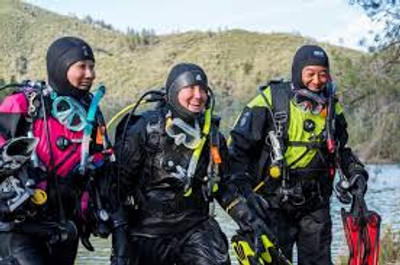Wetsuits vs. Drysuits: Choosing the Right Gear for Southern California Diving
Posted by Dive Professional Audrey Stavish on on Jun 4th 2024
When diving, whether exploring tropical reefs or icy lakes, having the right exposure protection is crucial. Here’s a quick guide to understanding the basics and differences between wetsuits and drysuits, and what’s best for diving in Southern California.
Wetsuits vs. Drysuits
- Wetsuits: Simpler, more mobile, and ideal for warmer waters. They trap a thin layer of water between your skin and the suit, which your body heat warms. Made from neoprene, they come in various styles and thicknesses (3mm, 5mm, 7mm).
- Drysuits: Perfect for colder conditions, requiring additional training and maintenance. They use air for insulation, allowing you to wear thermal clothing underneath. Constructed from waterproof materials like neoprene or trilaminate, they keep you dry with wrist and neck seals and built-in valves for air management.
Warmth and Suitability
Wetsuits are suitable for tropical and temperate waters. For temperatures below 10ºC/50ºF, drysuits offer necessary warmth and are mandatory for ice diving. Drysuits rely on undergarments for warmth, allowing for adaptability to different temperatures.
Training and Flexibility
Diving with a drysuit requires specific training, such as the PADI Dry Suit Diver course, to manage the air inside and maintain buoyancy. Wetsuits are straightforward: put it on, adjust weights, and dive. Wetsuits generally offer more flexibility, while drysuits can feel bulkier and need careful air management.
Comfort, Cost, and Maintenance
Here in SoCal, a 7mm neoprene wetsuit is considered standard. Divers in the area are almost always trained wearing a 7mm wetsuit; however, sometimes it can be too cold for comfort. Especially as the water cools down in the winter and into the spring, and for those who tend to run cold. If diving is a regular hobby, upgrading to a drysuit may be worth considering.
Comfort is subjective. Wetsuits are easier to swim in but can be tricky to put on and take off. Drysuits provide better warmth, especially between dives. Drysuits are typically more expensive but can last longer with proper maintenance. Wetsuits need simple rinsing and storage, while drysuits require more care, including zipper lubrication and seal repairs.
Find Your Perfect Suit at Eco Dive Center
At Eco Dive Center, we offer a wide range of wetsuits and drysuits to suit your diving needs. Our expert staff can help you choose the best suit for your adventures. Plus, with the purchase of a drysuit, you'll receive a free drysuit course to ensure you’re fully prepared and confident. Many divers in Southern California use both wetsuits and drysuits depending on the season and dive conditions, allowing for year-round diving comfort.
Visit Eco Dive Center today to explore our selection and take advantage of our exclusive offers. Dive smart, dive safe, and dive comfortably in Southern California's beautiful waters.

